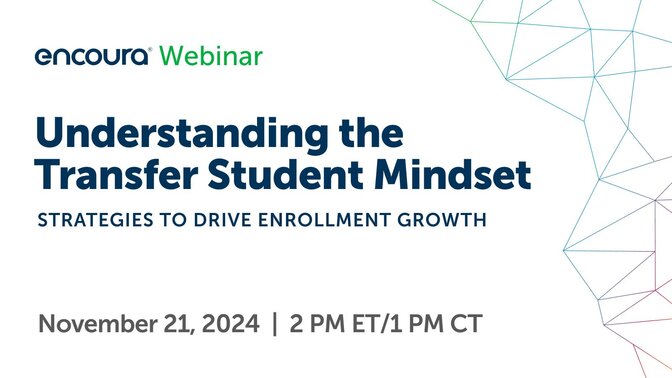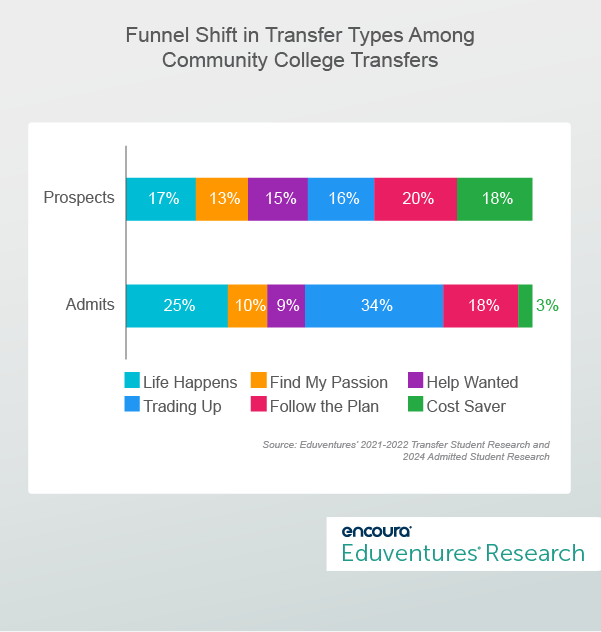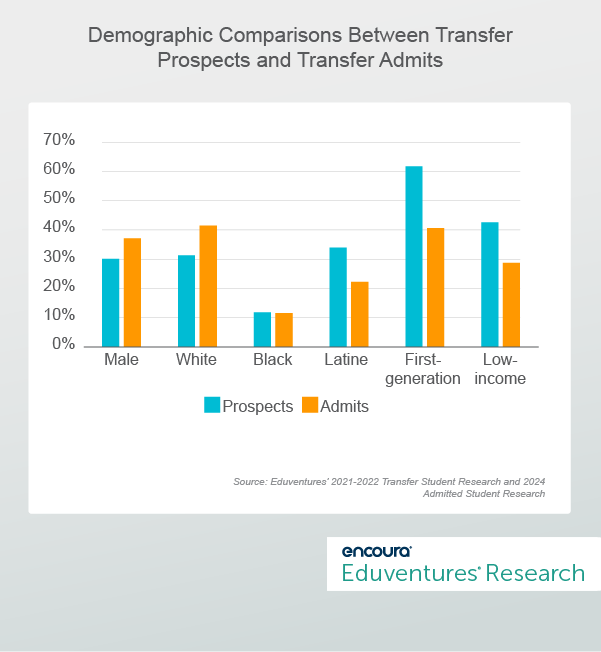According to Eduventures’ 2024 Admitted Student Research™, 63% of community college transfer students cited affordability as a core enrollment driver compared to 55% of high school graduates who were admitted as first-time students. This aligns with the notion of the typical transfer student who starts at a community college to make their education more affordable.
Yet, as the cost and value of higher education remain under public scrutiny, our research indicates that the primarily cost-driven community college transfer student is not the only—or even most common—type of transfer student enrolling in four-year institutions today.
Understanding Transfer Types
Transfer students who start at community colleges are widely known for being practical decision makers with a strong focus on cost. In the aggregate, practical considerations like major availability (42%), cost (37%), and financial aid availability (31%) indeed outweigh academic factors like prestige (22%) or rigor (13%) in the transfer school selection among former community college students. But our research also shows that not all transfer students are created equally.
The Eduventures 2024 Admitted Student Research includes about 1,200 students—just 7% of the total sample—who reported they are enrolling as transfer students. Of these transfer students, 70% were enrolling at a four-year institution this fall after starting off at a community college.
Segmenting transfer students by their transfer reasons and decision-making motivations, Eduventures identifies the following six Transfer Types:
- Life Happens™: Personal circumstances have changed for these students, and now they are looking for a more flexible or affordable education option, often in a new location.
- Find My Passion™: These students want a school that offers a specific program or location, which they perceive to be a better choice than their current school.
- Help Wanted™: Looking for a change, these students are often driven by academic struggles. They seek better support services and, sometimes, more flexibility.
- Trading Up™: These students seek more prestige and rigor. Some also want to spread their wings and move farther from home.
- Follow the Plan™: Transferring to a more rigorous school was always part of the plan. These students seek a specific location, and a school that will likely accept them.
- Cost Saver™: These students always wanted to transfer to save money. Cost is the single most important factor in selecting a transfer school.
These six Transfer Student Types™ highlight that transfer students are not monolithic. Like other prospective students, this segment is diverse and needs varied recruitment conversations and support levels.
In previous research, we learned that the pandemic has increased the proportion of prospective transfer students who fall into less intentional and more circumstantial Transfer Types—Life Happens and Trading Up—and decreased the proportion who carefully plan their paths—Follow the Plan and Cost Saver.
We also know that the proportion of each Transfer Type shifts between the prospect and admit stages, providing important insights into the kinds of community college students who successfully make it through the recruitment funnel. Figure 1 shows the proportion of each Transfer Type at the prospect stage and at the admit stage.
Figure 1.
Paradoxically, Figure 1 shows that the Transfer Types who carefully plan their transfer pathways from the beginning of their higher education journeys seem to be less likely to succeed through the funnel. Somewhere in their transfer journeys, these determined students seem to give up on their plans. The Cost Saver—already affected by pandemic tumult—can hardly be found among admitted transfer students. Instead, we see an increase in Life Happens and Trading Up students—those who didn’t think they would transfer when they first enrolled in college.
What does this mean? While cost is a core enrollment driver for nearly two-thirds of admitted transfer students, the Cost Saver student who doubles down on an affordable pathway through college—the Transfer Type most institutions are addressing in their recruitment messaging—seems to get lost in the funnel. How can we make sense of this?
Demographic comparisons between transfer prospects and transfer admits illuminate the underlying problem (Figure 2).
Figure 2.
Figure 2 shows which demographic segments are least likely to succeed through the transfer funnel. Notably, the largest differences between prospects and admits are among first-generation students and students from low-income households—the very students who are meant to benefit the most from the transfer pathway. We also see a drop in Latine students and an increase in White and male transfers.
The transfer process, intended to create greater equity and access in higher education, seems to be unable to remove barriers for the students it intends to serve. Cost messaging won’t solve this problem.
But cost messaging is important in transfer recruitment communications. Most transfer students consider cost. But messaging cost and affordability alone is too simplistic.
Transfer students weigh many other considerations and decision drivers that institutions should also address in their messaging. The truly cost-focused student, however, needs more than just messaging. They need greater financial support to succeed in their goals. In fact, all transfer prospects need appropriate support in addition to compelling messaging. Transfer Types allow us to understand which type of support may be needed.
The Bottom Line
Higher education has an access problem. It can be found at all levels, including those specifically meant to help underserved student populations. In pursuit of greater equity, and to buffer against enrollment declines in first-year student populations, institutions must provide not only nuanced messaging but also more support to transfer students across all Transfer Types, including:
- Financial support. Clearly, the community college to four-year pathway is not as affordable as touted. Transfer prospects often find themselves with less financial aid and fewer accepted credits than expected at their destination schools.
- Recruitment support. The transfer process is complex. Community college students may be intimidated by the rules and documentation required to successfully apply and enter with as many credit hours as possible.
- Academic and social support. Even the students who succeed through the funnel require additional support once on campus. Less prepared for their journeys than the careful planners who drop out of the pipeline, these students can benefit from onboarding and coaching at their new institutions to make sure they can succeed academically and socially through graduation.

Identify the top factors that truly influence transfer students in college search and the best digital strategies to engage them.



